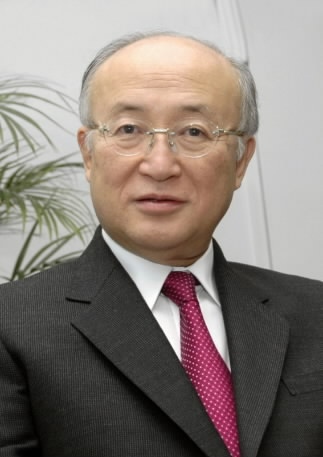IAEA and HICARE join hands for medical care of the radiation-exposed
Jul. 20, 2010
by Sakiko Masuda, Staff Writer
On July 18, it was learned that the Hiroshima International Council for Health Care of the Radiation-exposed (HICARE), an organization formed by Hiroshima Prefecture, the City of Hiroshima, and other entities, and the International Atomic Energy Agency (IAEA) will sign and exchange memorandums of understanding for a joint effort in medical care for the radiation-exposed.
Yukiya Amano, the Director General of the IAEA, will attend the Peace Memorial Ceremony in Hiroshima on August 6. This is the first time the director of the IAEA is attending the ceremony. After the ceremony, HICARE and the IAEA will formalize their ties.
The experience of medical care for A-bomb survivors that has accumulated in Hiroshima will be utilized in treating radiation victims under the international auspices of the IAEA.
The areas of collaboration between the two organizations will include joint study on the effects of radiation on the human body, the exchange of information on treating those exposed to radiation in the event of an emergency, and the cultivation of human resources through the training of doctors and researchers, among other efforts.
On the afternoon of August 6, the signing will be held at the Hiroshima Red Cross Hospital & Atomic-bomb Survivors Hospital. Hiroo Dohy, president of both the hospital and HICARE, will take part in the signing ceremony as the representative of HICARE.
The IAEA, based in Vienna, Austria, is the world's nuclear watchdog, working for the peaceful use of nuclear energy and seeking to prevent the diversion of nuclear materials for military use. Mr. Amano formerly served in Japan's Ministry of Foreign Affairs and succeeded Mohamed ElBaradei last December, becoming the first Asian director of the IAEA.
In preparation for nuclear accidents and other radiation-related disasters, on June 18, the IAEA registered Hiroshima University, the Japan Atomic Energy Agency, and the National Institute of Radiological Sciences as part of the Response Assistance Network (RANET).
(Originally published on July 19, 2010)
On July 18, it was learned that the Hiroshima International Council for Health Care of the Radiation-exposed (HICARE), an organization formed by Hiroshima Prefecture, the City of Hiroshima, and other entities, and the International Atomic Energy Agency (IAEA) will sign and exchange memorandums of understanding for a joint effort in medical care for the radiation-exposed.
Yukiya Amano, the Director General of the IAEA, will attend the Peace Memorial Ceremony in Hiroshima on August 6. This is the first time the director of the IAEA is attending the ceremony. After the ceremony, HICARE and the IAEA will formalize their ties.
The experience of medical care for A-bomb survivors that has accumulated in Hiroshima will be utilized in treating radiation victims under the international auspices of the IAEA.
The areas of collaboration between the two organizations will include joint study on the effects of radiation on the human body, the exchange of information on treating those exposed to radiation in the event of an emergency, and the cultivation of human resources through the training of doctors and researchers, among other efforts.
On the afternoon of August 6, the signing will be held at the Hiroshima Red Cross Hospital & Atomic-bomb Survivors Hospital. Hiroo Dohy, president of both the hospital and HICARE, will take part in the signing ceremony as the representative of HICARE.
The IAEA, based in Vienna, Austria, is the world's nuclear watchdog, working for the peaceful use of nuclear energy and seeking to prevent the diversion of nuclear materials for military use. Mr. Amano formerly served in Japan's Ministry of Foreign Affairs and succeeded Mohamed ElBaradei last December, becoming the first Asian director of the IAEA.
In preparation for nuclear accidents and other radiation-related disasters, on June 18, the IAEA registered Hiroshima University, the Japan Atomic Energy Agency, and the National Institute of Radiological Sciences as part of the Response Assistance Network (RANET).
(Originally published on July 19, 2010)








